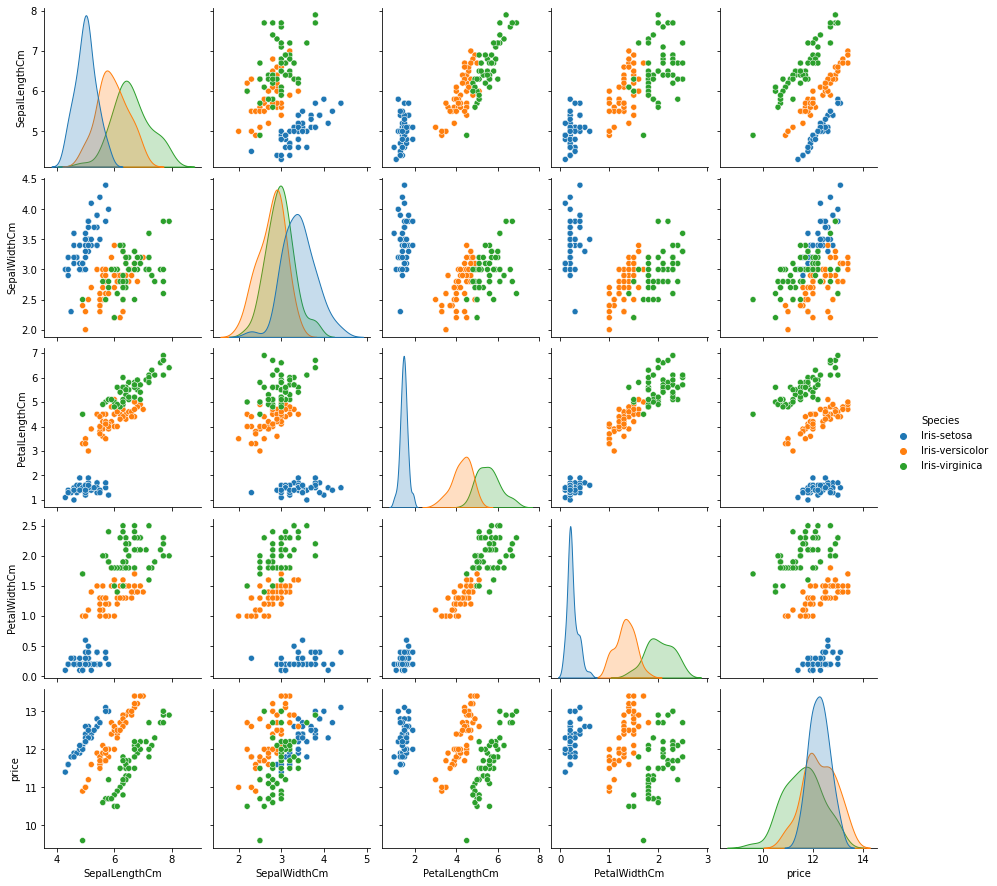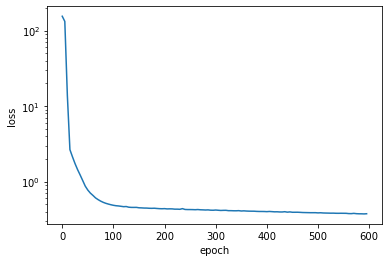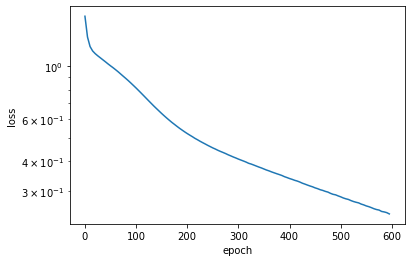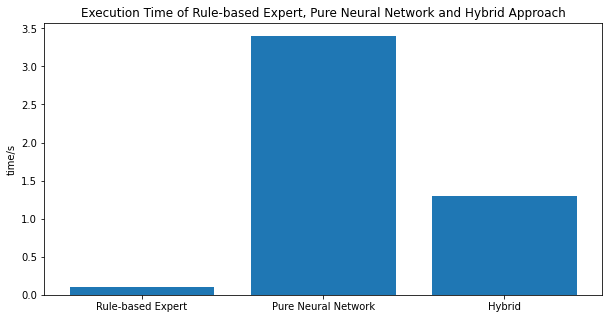import pandas as pd
import numpy as np
import matplotlib.pyplot as plt
import seaborn as snsdf = pd.read_csv("data/Iris.csv")
df.head()
<style scoped>
.dataframe tbody tr th:only-of-type {
vertical-align: middle;
}
</style>
.dataframe tbody tr th {
vertical-align: top;
}
.dataframe thead th {
text-align: right;
}
| Id | SepalLengthCm | SepalWidthCm | PetalLengthCm | PetalWidthCm | Species | |
|---|---|---|---|---|---|---|
| 0 | 1 | 5.1 | 3.5 | 1.4 | 0.2 | Iris-setosa |
| 1 | 2 | 4.9 | 3.0 | 1.4 | 0.2 | Iris-setosa |
| 2 | 3 | 4.7 | 3.2 | 1.3 | 0.2 | Iris-setosa |
| 3 | 4 | 4.6 | 3.1 | 1.5 | 0.2 | Iris-setosa |
| 4 | 5 | 5.0 | 3.6 | 1.4 | 0.2 | Iris-setosa |
现在假定这人们对这三种花有价格偏好:
其中:Iris-setosa的价格为$7.00,Iris-versicolor的价格为$5.00,Iris-virginica的价格为$3.00。
而总价格 = (SepalLength + PetalWidth)+ 基础价格
现在,我们尝试通过SepalLengthCm, SepalWidthCm, PetalLengthCm, PetalWidthCm这五个特征来预测Iris的价格
# 新增price列
df["price"] = np.zeros(len(df))
# 遍历每一行
for i in range(len(df)):
# 如果是setosa,price=5
if df.iloc[i]["Species"] == "Iris-setosa":
df.loc[i,"price"] = (df.iloc[i]["SepalLengthCm"]+df.iloc[i]["PetalWidthCm"])+7
# 如果是versicolor,price=2
elif df.iloc[i]["Species"] == "Iris-versicolor":
df.loc[i,"price"] = (df.iloc[i]["SepalLengthCm"]+df.iloc[i]["PetalWidthCm"])+5
# 如果是virginica,price=3
elif df.iloc[i]["Species"] == "Iris-virginica":
df.loc[i,"price"] = (df.iloc[i]["SepalLengthCm"]+df.iloc[i]["PetalWidthCm"])+3
else:
print("error")
df.head()
<style scoped>
.dataframe tbody tr th:only-of-type {
vertical-align: middle;
}
</style>
.dataframe tbody tr th {
vertical-align: top;
}
.dataframe thead th {
text-align: right;
}
| Id | SepalLengthCm | SepalWidthCm | PetalLengthCm | PetalWidthCm | Species | price | |
|---|---|---|---|---|---|---|---|
| 0 | 1 | 5.1 | 3.5 | 1.4 | 0.2 | Iris-setosa | 12.3 |
| 1 | 2 | 4.9 | 3.0 | 1.4 | 0.2 | Iris-setosa | 12.1 |
| 2 | 3 | 4.7 | 3.2 | 1.3 | 0.2 | Iris-setosa | 11.9 |
| 3 | 4 | 4.6 | 3.1 | 1.5 | 0.2 | Iris-setosa | 11.8 |
| 4 | 5 | 5.0 | 3.6 | 1.4 | 0.2 | Iris-setosa | 12.2 |
# visualize the data
sns.pairplot(df.drop(["Id"],axis=1), hue="Species")<seaborn.axisgrid.PairGrid at 0x13f484ee0>
# 分训练集和测试集
train_df = df.sample(frac=0.8, random_state=0)
test_df = df.drop(train_df.index)setosa = train_df[train_df["Species"] == "Iris-setosa"]
print("setosa",setosa.SepalLengthCm.mean(),setosa.SepalWidthCm.mean(),setosa.PetalLengthCm.mean(),setosa.PetalWidthCm.mean())
versicolor = train_df[train_df["Species"] == "Iris-versicolor"]
print("versicolor-mean",versicolor.SepalLengthCm.mean(),versicolor.SepalWidthCm.mean(),versicolor.PetalLengthCm.mean(),versicolor.PetalWidthCm.mean())
print("versicolor-max", versicolor.SepalLengthCm.max(),versicolor.SepalWidthCm.max(),versicolor.PetalLengthCm.max(),versicolor.PetalWidthCm.max())
print("versicolor-min", versicolor.SepalLengthCm.min(),versicolor.SepalWidthCm.min(),versicolor.PetalLengthCm.min(),versicolor.PetalWidthCm.min())
virginica = train_df[train_df["Species"] == "Iris-virginica"]
print("virginica-mean",virginica.SepalLengthCm.mean(),virginica.SepalWidthCm.mean(),virginica.PetalLengthCm.mean(),virginica.PetalWidthCm.mean())
print("virginica-max", virginica.SepalLengthCm.max(),virginica.SepalWidthCm.max(),virginica.PetalLengthCm.max(),virginica.PetalWidthCm.max())
print("virginica-min", virginica.SepalLengthCm.min(),virginica.SepalWidthCm.min(),virginica.PetalLengthCm.min(),virginica.PetalWidthCm.min())setosa 4.9875 3.4174999999999995 1.4675 0.25
versicolor-mean 5.920512820512819 2.77948717948718 4.253846153846155 1.3307692307692305
versicolor-max 7.0 3.4 5.1 1.6
versicolor-min 4.9 2.0 3.0 1.0
virginica-mean 6.546341463414634 2.951219512195122 5.504878048780488 2.0024390243902435
virginica-max 7.9 3.8 6.9 2.5
virginica-min 4.9 2.2 4.5 1.4
setosa.PetalLengthCm.max()1.9
# Approach 1:
# 先验知识: 花的价格和(花的长度+花的宽度+花的种类)有关系
# 使用基于规则的专家系统,将数据分为三类,再用先验知识进行线性拟合
# 该基于规则的专家系统逻辑如下:
# 假设这些规则是植物学家的经验
def which_class(sl,sw,pl,pw):
if pl <= 1.9:
return "Iris-setosa"
if sl > 6.8 or sw > 3.2 or pl > 4.9 or pw > 1.6:
return "Iris-virginica"
if sw < 2.2 or pl < 3.0 or pw < 1.4:
return "Iris-versicolor"
else:
setosa_mean = np.array([4.98,4.41,1.56,0.25])
versicolor_mean = np.array([5.92, 2.88, 4.25, 0.33])
virginica_mean = np.array([5.54, 2.95, 5.60, 1.00])
# find the min distance
setosa_dist = np.linalg.norm(setosa_mean - np.array([sl,sw,pl,pw]))
versicolor_dist = np.linalg.norm(versicolor_mean - np.array([sl,sw,pl,pw]))
virginica_dist = np.linalg.norm(virginica_mean - np.array([sl,sw,pl,pw]))
if setosa_dist < versicolor_dist and setosa_dist < virginica_dist:
return "Iris-setosa"
elif versicolor_dist < setosa_dist and versicolor_dist < virginica_dist:
return "Iris-versicolor"
elif virginica_dist < setosa_dist and virginica_dist < versicolor_dist:
return "Iris-virginica"
else:
return "error"
pred1 = [which_class(row[1],row[2],row[3],row[4]) for row in test_df.values]
test_df["pred_cls_1"] = pred1
pred1 = [which_class(row[1],row[2],row[3],row[4]) for row in train_df.values]
train_df["pred_cls_1"] = pred1
# 准确率
print(f"基于规则的方法在测试集上的准确率为{(test_df.pred_cls_1==test_df.Species).sum()/len(test_df):.3f}, 在训练集上的准确率为{(train_df.pred_cls_1==train_df.Species).sum()/len(train_df):.3f}")
def calc_price(sl,sw,pl,pw,c):
if c == "Iris-setosa":
setosa = train_df[train_df["Species"] == "Iris-setosa"]
setosa_b = (setosa.price-setosa.SepalLengthCm-setosa.PetalWidthCm).mean()
return sl+pw+setosa_b
if c == "Iris-versicolor":
versicolor = train_df[train_df["Species"] == "Iris-versicolor"]
versicolor_b = (versicolor.price-versicolor.SepalLengthCm-versicolor.PetalWidthCm).mean()
return sl+pw+versicolor_b
if c == "Iris-virginica":
virginica = train_df[train_df["Species"] == "Iris-virginica"]
virginica_b = (virginica.price-virginica.SepalLengthCm-virginica.PetalWidthCm).mean()
return sl+pw+virginica_b
else:
return 0
pred2 = [calc_price(row[0],row[1],row[2],row[3],row[4]) for row in test_df[["SepalLengthCm","SepalWidthCm","PetalLengthCm","PetalWidthCm","pred_cls_1"]].values]
test_df["pred_price_1"] = pred2
pred2 = [calc_price(row[0],row[1],row[2],row[3],row[4]) for row in train_df[["SepalLengthCm","SepalWidthCm","PetalLengthCm","PetalWidthCm","pred_cls_1"]].values]
train_df["pred_price_1"] = pred2
# MSE
train_mse = ((train_df.price-train_df.pred_price_1)**2).mean()
test_mse = ((test_df.price-test_df.pred_price_1)**2).mean()
print(f"基于规则的方法在测试集上的MSE为{test_mse:.3f}, 在训练集上的MSE为{train_mse:.3f}")基于规则的方法在测试集上的准确率为0.900, 在训练集上的准确率为0.933
基于规则的方法在测试集上的MSE为0.400, 在训练集上的MSE为0.267
# Approach 2:
# 无先验知识,最流行的端到端模型,直接训回归模型
import torch
import torch.nn as nn
import torch.nn.functional as F
import torch.optim as optim
from torch.utils.data import Dataset, DataLoader
# 准备数据集
train_x = torch.tensor(train_df[["SepalLengthCm","SepalWidthCm","PetalLengthCm","PetalWidthCm"]].values).float()
train_y = torch.tensor(train_df["price"].values).float()
test_x = torch.tensor(test_df[["SepalLengthCm","SepalWidthCm","PetalLengthCm","PetalWidthCm"]].values).float()
test_y = torch.tensor(test_df["price"].values).float()
# 定义数据集
class IrisDataset(Dataset):
def __init__(self, x, y):
self.x = x
self.y = y
def __getitem__(self, index):
return self.x[index], self.y[index]
def __len__(self):
return len(self.x)
# 定义Dataloader
train_loader = DataLoader(dataset=IrisDataset(train_x, train_y), batch_size=8, shuffle=True)
test_loader = DataLoader(dataset=IrisDataset(test_x, test_y), batch_size=8, shuffle=True)
# 定义模型
class MultiLayerRegression(nn.Module):
def __init__(self,input_size:int = 4, output_size:int =1, hidden_size:int=10, hidden_layers:int=1):
super().__init__()
self.hidden_layers = hidden_layers
self.hidden_size = hidden_size
self.input_size = input_size
self.output_size = output_size
self.layers = nn.ModuleList()
for i in range(self.hidden_layers):
if i == 0:
self.layers.append(nn.Linear(self.input_size, self.hidden_size))
else:
self.layers.append(nn.Linear(self.hidden_size, self.hidden_size))
self.output = nn.Linear(self.hidden_size, self.output_size)
def forward(self, x):
for layer in self.layers:
x = F.relu(layer(x))
return self.output(x)
# 训练模型
model = MultiLayerRegression(input_size=4, output_size=1, hidden_size=10, hidden_layers=3)
criterion = nn.MSELoss()
optimizer = optim.SGD(model.parameters(), lr=1e-4)
losses = []
for epoch in range(1000):
for i, (x, y) in enumerate(train_loader):
y_pred = model(x)
loss = criterion(y_pred.squeeze(), y)
optimizer.zero_grad()
loss.backward()
optimizer.step()
if epoch % 5 == 0:
y_pred = model(test_x)
loss = criterion(y_pred.squeeze(), test_y)
losses.append(loss.item())
# 预测
y_pred = model(train_x)
train_df["pred_price_2"] = y_pred.detach().numpy()
y_pred = model(test_x)
loss = criterion(y_pred.squeeze(), test_y)
print("loss: {}".format(loss.item()))
test_df["pred_price_2"] = y_pred.detach().numpy()
# 将y_pred和test_y画出来
plt.plot(test_y.numpy(), label="y_test")
plt.plot(y_pred.detach().numpy(), label="y_pred")
plt.xlabel("index")
plt.ylabel("price")
plt.legend()loss: 0.33261242508888245
<matplotlib.legend.Legend at 0x14887f7c0>
# 做出Approach 2的loss图
plt.plot(np.arange(0,600,5),losses[:120])
plt.xlabel("epoch")
plt.ylabel("loss")
plt.yscale("log")train_mse = ((train_df.price-train_df.pred_price_2)**2).mean()
test_mse = ((test_df.price-test_df.pred_price_2)**2).mean()
print(f"纯神经网络的方法在测试集上的MSE为{test_mse:.3f}, 在训练集上的MSE为{train_mse:.3f}")纯神经网络的方法在测试集上的MSE为0.333, 在训练集上的MSE为0.375
# Approach 3:
# 有先验知识,分类这一步用神经网络,但是价格预测一步用基于规则的专家系统
# 先验知识: 花的价格和(花的长度+花的宽度+花的种类)有关系
# 准备数据
train_x = torch.tensor(train_df[["SepalLengthCm","SepalWidthCm","PetalLengthCm","PetalWidthCm"]].values).float()
species_map = {species:i for i, species in enumerate(train_df.Species.unique())}
train_y = torch.tensor([species_map[species] for species in train_df.Species]).long()
test_x = torch.tensor(test_df[["SepalLengthCm","SepalWidthCm","PetalLengthCm","PetalWidthCm"]].values).float()
test_y = torch.tensor([species_map[species] for species in test_df.Species]).long()
class IrisDataset(Dataset):
def __init__(self, x, y):
self.x = x
self.y = y
def __getitem__(self, index):
return self.x[index], self.y[index]
def __len__(self):
return len(self.x)
train_loader = DataLoader(dataset=IrisDataset(train_x, train_y), batch_size=8, shuffle=True)
test_loader = DataLoader(dataset=IrisDataset(test_x, test_y), batch_size=8, shuffle=True)
class MultiLayerClassification(nn.Module):
def __init__(self,input_size:int = 4, output_size:int =3, hidden_size:int=10, hidden_layers:int=1):
super().__init__()
self.hidden_layers = hidden_layers
self.hidden_size = hidden_size
self.input_size = input_size
self.output_size = output_size
self.layers = nn.ModuleList()
for i in range(self.hidden_layers):
if i == 0:
self.layers.append(nn.Linear(self.input_size, self.hidden_size))
else:
self.layers.append(nn.Linear(self.hidden_size, self.hidden_size))
self.output = nn.Linear(self.hidden_size, self.output_size)
def forward(self, x):
for layer in self.layers:
x = F.relu(layer(x))
return self.output(x)
model = MultiLayerClassification(input_size=4, output_size=3, hidden_size=10, hidden_layers=1)
criterion = nn.CrossEntropyLoss()
optimizer = optim.SGD(model.parameters(), lr=1e-3)
losses = []
for epoch in range(600):
for i, (x, y) in enumerate(train_loader):
y_pred = model(x)
loss = criterion(y_pred, y)
optimizer.zero_grad()
loss.backward()
optimizer.step()
if epoch % 5 == 0:
y_pred = model(test_x)
loss = criterion(y_pred, test_y)
losses.append(loss.item())
# 预测
y_pred = model(train_x)
map_back = {i:species for species, i in species_map.items()}
train_df["pred_cls_3"] = [map_back[i.item()] for i in y_pred.argmax(1)]
y_pred = model(test_x)
loss = criterion(y_pred, test_y)
print("loss: {}".format(loss.item()))
test_df["pred_cls_3"] = [map_back[i.item()] for i in y_pred.argmax(1)]
# 预测正确率
train_correct = (train_df.pred_cls_3 == train_df.Species).mean()
test_correct = (test_df.pred_cls_3 == test_df.Species).mean()
print(f"结合规则和神经网络的方法在测试集上的正确率为{test_correct:.3f}, 在训练集上的正确率为{train_correct:.3f}")loss: 0.24082805216312408
结合规则和神经网络的方法在测试集上的正确率为0.933, 在训练集上的正确率为0.983
# 做出Approach 2的loss图
plt.plot(np.arange(0,600,5),losses)
plt.xlabel("epoch")
plt.ylabel("loss")
plt.yscale("log")pred2 = [calc_price(row[0],row[1],row[2],row[3],row[4]) for row in test_df[["SepalLengthCm","SepalWidthCm","PetalLengthCm","PetalWidthCm","pred_cls_3"]].values]
test_df["pred_price_3"] = pred2
pred2 = [calc_price(row[0],row[1],row[2],row[3],row[4]) for row in train_df[["SepalLengthCm","SepalWidthCm","PetalLengthCm","PetalWidthCm","pred_cls_3"]].values]
train_df["pred_price_3"] = pred2
# MSE
train_mse = ((train_df.price-train_df.pred_price_3)**2).mean()
test_mse = ((test_df.price-test_df.pred_price_3)**2).mean()
print(f"结合规则和神经网络的方法在测试集上的MSE为{test_mse:.3f}, 在训练集上的MSE为{train_mse:.3f}")结合规则和神经网络的方法在测试集上的MSE为0.267, 在训练集上的MSE为0.067
# 画柱状图
# Rule-based:0.1 Neural Network:3.4 Hybrid: 1.3
plt.figure(figsize=(10,5))
plt.bar(["Rule-based Expert","Pure Neural Network","Hybrid"],[0.1,3.4,1.3])
plt.ylabel("time/s")
# set table name
plt.title("Execution Time of Rule-based Expert, Pure Neural Network and Hybrid Approach")Text(0.5, 1.0, 'Execution Time of Rule-based Expert, Pure Neural Network and Hybrid Approach')
# Classification and MSE in test set
# Cls: Rule-based:0.9 Neural Network: NaN Hybrid: 0.967
# MSE: Rule-based: 0.40 Neural Network: 0.23 Hybrid: 0.133
# Draw Cls and MSE in same bar
plt.figure(figsize=(10,5))
data = [["Rule-based Expert",0.9,0.4],
["Pure Neural Network",np.nan,0.23],
["Hybrid",0.967,0.133]]
df = pd.DataFrame(data,columns=["Approach","Cls Accuracy","MSE"])
df.plot(x="Approach",y=["Cls Accuracy","MSE"],kind="bar", figsize=(10,5))<AxesSubplot:xlabel='Approach'>
<Figure size 720x360 with 0 Axes>





